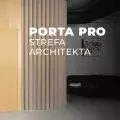A metaphor for the current situation of women in Poland in the scenery of a brutalist city. In the artist's phenomenal music video announcing the "Brut" album, the backdrop to the music are completely non-accidental architectural pearls, including the most exclusive apartment building of the People's Republic of Poland.
Game Change
On Wednesday, March 3, the music video of Brodka's latest song " Game Change" premiered online. The song heralds the new album. The video is a kind of mirror of the problems of today's world, but also a critique of consumerism and patriarchy. The vision of director Monika Brodka and director Przemek Dzienis included the creation of a city, the role of which is played by Warsaw. The capital becomes a "brutalist city of Brut". The characteristic skyscraper-hammer and the interiors of the Palace of Culture are the backdrop for the artist and the army of women stepping into men's shoes, suits and life roles.
This story, although abstract, is in a way a reference to the current situation of women in Poland," reads the press materials.
The idea for the clip was inspired by the story of the Albanian Kanun Virgins (Sworn Virgins). Women who, by taking a vow of chastity, assume a male role in society in order to gain all the privileges ascribed to the male gender," Brodka explains in an interview with Gazeta Wyborcza.
The brutalist city of "BRUT" is home to a woman who assumes her husband's role after his death. The only attribute of her femininity is a corset. She communicates with other women through dance and strange tics, and together they form a unique gang. This story, although abstract, is in a way a reference to the current situation of women in Poland," the artist stresses.
Warsaw in the role of a BRUT city
"Gmoch", "jaw dropped" or "hammer" - the building we see in the first seconds of the film is a Warsaw skyscraper, designed in 1964 by Jan Boguslawski and Bohdan Gniewewski. The construction of the skyscraper was completed in 1976, when the national soccer team led by Jacek Gmoch was celebrating its triumphs, and the decade of Edward Gierek was underway in the People's Republic of Poland. Terrifying and fascinating at the same time. It was one of the first high-rise buildings in Warsaw.
Hammer | WikiCommons
The 19-story PUMA-y skyscraper (foreigners' service office at the time) was located on the edge of the Vistula escarpment, on the site of an ophthalmic hospital (demolished during World War II). It was originally designed to function as an upscale Polish hotel, enticing Poles from abroad to return to the capital. It was redesigned to become a residential building (a so-called "devisemaker") with 140 high-standard apartments. Huge by the standards of the time, the units were as large as 40-65 meters. High-speed elevators and modern intercoms were installed. At the top of the skyscraper was a two-story restaurant with a roof terrace (18th and 19th floors). Today Smolna 8, though dusty and neglected, is one of Warsaw's gems of postwar modernism.
Fear of clouds
The erection of such tall residential buildings with 11 floors in Warsaw gained favor, only after a special resolution in the wave of the architectural thaw. However, high-rise buildings have always been controversial, and the architects themselves have argued on this issue. Fear of "living in the clouds" was a common phenomenon throughout Europe. In post-war London, initially climbing with momentum after a high-profile tragedy caused by a gas explosion in one of the skyscrapers, there were not enough takers for apartments above the tenth floor even among those waiting for social housing allocations. Shortly thereafter, the British capital's authorities curtailed investment in residential high-rises.
Interior of the Palace of Culture and Science | WikiCommons.
The utopian vision of a Brutalist building with so-called elevated standards is complemented by the interiors of the Palace of Culture and Science, together creating the outline of a BRUT city. Lined with marble, they resemble the glitz of the first early capitalist skyscrapers in New York or Chicago. The palace hall still gives the impression of being spacious, and at the time of its construction it was one of the largest interiors of its kind in Warsaw. It is striking for its austere monumentality, which is given by facing the walls with light sandstone.
Warsaw's cinematic incarnation of the BRUT city is mesmerizing, transporting the viewer into a dystopian world, which is coherently created with music by Monika Brodka. Forgotten architectural gems can shine anew, thanks to the new functions given to them by pop culture.
Marta Kowalska




















